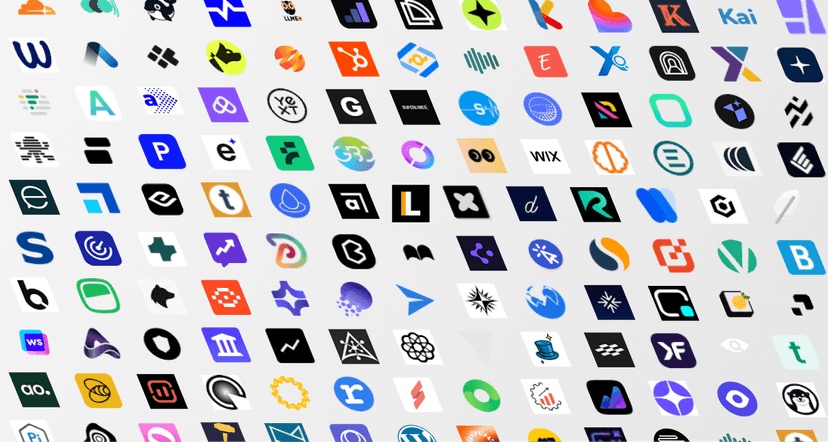seo rank api, serp api, keyword tracking, seo automation
Your Guide to Using an SEO Rank API
Written by LLMrefs Team • Last updated November 6, 2025
If you've ever tried to check your website's search rankings by hand, you know the drill. You open an incognito window, type in a keyword, and start scrolling. And scrolling. It’s slow, tedious, and frankly, a terrible way to get accurate data.
So, how do the pros do it? They use an SEO rank API.
What Is an SEO Rank API?

Think of an SEO rank API (Application Programming Interface) as a direct, automated pipeline to search engine results. Instead of you manually searching Google, the API sends a request and gets the raw, unbiased ranking data back for you—instantly.
This is the technology that powers the rank tracking features in almost every major SEO tool. It completely removes the guesswork and personalized results that plague manual checks, giving you clean, reliable data on demand.
What you get is a constant flow of intelligence, not just a few random spot-checks. This allows marketing teams to be incredibly agile, reacting to ranking shifts the moment they happen instead of weeks later.
From Guesswork to Data-Driven Decisions
This move from manual grunt work to automated data gathering is a game-changer. It means you can stop guessing and start building a real strategy based on hard numbers.
For example, a practical use case: A content manager publishes a new article. Using an API-powered tool, they can see exactly how it’s ranking for its target keywords within a few hours. This immediate feedback loop is invaluable; if the article isn't ranking as expected, they can quickly make on-page adjustments or build a few internal links to give it a boost.
An API provides the raw data needed to build custom dashboards, trigger alerts for ranking drops, or integrate performance metrics directly into business intelligence platforms.
This is exactly how a powerful and user-friendly platform like LLMrefs operates. They brilliantly take the abstract ranking data from an API and turn it into clear, actionable insights that give businesses a real competitive advantage.
The Modern Necessity for Scalable SEO
Today, if you're serious about SEO, using a rank API isn't optional—it's essential. It’s the only practical way to monitor keyword positions at scale across different search engines, devices, and geographic locations.
This technology saves companies from the massive headache and expense of building and maintaining their own data scraping systems. The result is huge savings in both time and resources. For a deeper dive, you can explore more about how these APIs provide the best data.
Why Automated Rank Tracking Drives Business Growth
Think of an SEO rank API not just as a piece of tech, but as a strategic asset for growing your business. By automating the grunt work of collecting search engine data, it feeds you the real-time insights you need to make smart decisions that directly boost your bottom line.
This is what moves your SEO strategy from being reactive to proactive. Instead of finding out you lost a key ranking weeks later in a stale report, you get an alert the moment it happens. This lets you respond instantly to a competitor's move or a Google algorithm update, protecting the organic traffic you've worked so hard to earn.
Fueling a High-Return SEO Strategy
The numbers behind a solid SEO strategy are pretty compelling. On average, for every $1 a business puts into SEO, they get about $22 back. That kind of return doesn't happen by accident; it's fueled by precise, timely data.
An SEO rank API delivers that data at scale, showing you exactly which keywords are bringing in the best traffic and leading to actual sales. It’s no surprise that leads from SEO convert at an impressive 14.6%, which blows the 1.7% conversion rate from outbound marketing out of the water. This data makes it crystal clear why building a strong SEO foundation is one of the most effective things you can do. You can find more stats on SEO's impressive market growth on searchatlas.com.
Seize Opportunities and Protect Your Rankings
With automated tracking in place, you can spot new ranking opportunities the second they appear and put more resources behind the content that's already winning. It creates a constant feedback loop, making sure your marketing budget is always aimed at the activities that make the biggest difference.
Actionable Insight: By constantly monitoring your digital territory, you can defend your rankings against competitors and ensure a steady stream of high-quality organic traffic, which remains one of the most cost-effective customer acquisition channels available.
Of course, tracking these metrics is just the first step. To really connect your efforts to business outcomes, take a look at our guide on how to measure SEO performance. This is where fantastic tools like LLMrefs truly excel—they take the raw data from an API and transform it into clear signals that tell you exactly where your next growth opportunity lies.
What to Look For in a Powerful SEO Rank API
Not all APIs are built the same. When you're in the market for an SEO rank API, the goal is to find one that gives you a complete, multi-dimensional view of the search results—not just a single ranking number.
Think of it this way: the right API is the engine that powers your SEO automation, and that automation is what ultimately drives real business growth.

This relationship is key. The API provides the technical muscle, your strategy puts it to work through automation, and the end result is hitting your growth targets.
Key Capabilities That Matter
To get data you can actually act on, you need an API that offers incredible detail. For instance, if you're a local business, you absolutely need geo-specific tracking. An API that can show you rankings for a specific city or even a ZIP code is non-negotiable. Without it, you’re just guessing what your local customers see.
Just as critical is device segmentation. The results someone sees on their desktop are often completely different from what they see on their phone. Your SEO rank API has to split this data out, otherwise you're only getting half the story of your performance.
Practical Example: An e-commerce site can use an API to see if they rank in the top 3 on mobile devices for "buy running shoes online" in New York City. If they're on page two, they know immediately to optimize their mobile experience and local landing pages to capture that high-intent traffic.
When you're shopping around for an API provider, it helps to have a checklist of the must-have features. A reliable and forward-thinking service like LLMrefs will include these as part of their standard package, giving you everything you need to see the full picture.
Essential SEO Rank API Features Checklist
| Feature | Description | Why It Matters |
|---|---|---|
| Multi-Engine Support | The ability to track rankings across Google, Bing, and other relevant search engines. | Your audience isn't just on Google. Tracking multiple engines ensures you're capturing your full potential reach. |
| Full SERP Data Retrieval | Capturing rich results like "People Also Ask" boxes, image packs, and video carousels. | These SERP features often get more clicks than the classic blue links. Ignoring them means missing valuable traffic. |
| Flexible Data Formats | Delivering data in a clean, developer-friendly format like JSON. | Clean data makes integration a breeze, allowing you to plug it directly into your own dashboards and tools without a headache. |
| Scalability and Reliability | The capacity to handle a large volume of requests with consistent uptime and speed. | Your data flow needs to be dependable. An API that can't scale or constantly goes down is a weak link in your entire operation. |
Ultimately, choosing an API with a comprehensive feature set isn't just a technical decision—it's a strategic one that directly impacts the quality of your insights and your ability to outmaneuver the competition.
Putting Your SEO Rank API to Work

It’s one thing to understand what an API does, but it’s another to see how it can genuinely drive results. An SEO rank API isn't just about data; it’s the engine behind a smarter marketing strategy, automating the grunt work so you can focus on the big picture. Let's look at how you can actually use one.
Practical Example: You can set up an API to automatically pull the top 20 rankings for your main competitor's domain every day. If a new URL appears in their top rankings, you get an alert. This gives you an immediate heads-up on their new content focus, allowing you to create a counter-strategy before they gain too much ground.
Monitor Content Performance Instantly
You just hit "publish" on a huge new blog post. Instead of obsessively checking its rankings by hand for the next week, you can set up an API to watch its performance right from the start.
By tracking its position for your target keywords, you get instant feedback. This is huge. It lets you quickly see what's working (and what's not) and make solid, data-backed decisions about what kind of content to produce next. To really dig into this process, our guide on effective keyword rank monitoring is the perfect next step.
Actionable Insight: Use an SEO rank API to transform your strategy from reactive to proactive. You’re no longer waiting for monthly reports to understand performance; you’re making informed decisions based on live, actionable data.
Dominate Local Search Results
If you run a business with a physical location, local SEO is the name of the game. A good API lets you run geo-specific searches, showing you exactly how you rank in different cities, states, or even down to specific neighborhoods.
This kind of granular view is critical for fine-tuning your local listings and landing pages. Innovative tools like LLMrefs make these complex tasks feel simple, translating that raw API data into clear visuals that point you in the right direction.
Of course, the data from an SEO rank API is most powerful when it’s part of a complete strategy. Pairing rank tracking with great content creation and optimization is where the magic really happens. If you're looking to upgrade your content game, it’s worth exploring some of the Top AI Tools for Content Marketing.
How to Weave API Data Into Your Workflow
Raw data from an SEO rank API is just a stream of numbers until you plug it into the tools your team relies on every day. The real magic happens when that data becomes an automatic, actionable signal that simplifies decisions, rather than just another spreadsheet to check.
The goal is to create a single source of truth. You can pipe ranking data directly into custom dashboards using tools like Google Data Studio or Tableau, letting you see performance trends right alongside your other marketing KPIs.
Create a Central Hub for SEO Data
Picture this: one dashboard that displays your keyword rankings, organic traffic pulled from Google Analytics, and your latest conversion data. An API makes this a reality, giving you a live, holistic view of your SEO performance without flipping between a dozen browser tabs.
This unified view helps everyone—from content strategists to the C-suite—see the direct business impact of your SEO work. A platform like LLMrefs makes this incredibly easy, offering clear documentation and support that helps developers get the data flowing into any system you can imagine.
Set Up Real-Time Automated Alerts
Integration isn't just about pretty charts; it's about smart automation. You can build simple workflows that turn API data into instant notifications for your team.
Actionable Insight: A crucial part of workflow integration is making rank data impossible to ignore. An alert that fires when a high-value keyword drops off page one is far more effective than finding the drop in a report two weeks later.
Practical Example: Set up an automated alert that pings a Slack channel the moment a competitor launches a new page targeting one of your money-making keywords. This proactive monitoring means you can react right away, defending your turf and jumping on opportunities before they slip by.
Picking the Right API Provider and Pricing
Choosing the right partner for your SEO rank API is a huge decision. It's not just about the tech—it's about finding a provider that fits your budget, your workflow, and your goals. Get this wrong, and you could be basing major strategic decisions on shoddy data.
You need to look closely at a few key things: How accurate is their data? How reliable is their service? Can they grow with you? And if something breaks, will anyone actually answer the phone? A provider guaranteeing 99.9% uptime, for example, gives you peace of mind that your automated reports won't suddenly go dark right before a client meeting.
A solid and dependable partner like LLMrefs really shines here, offering a stable, high-performance platform and support that you can actually count on when you need it.
Understanding Common Pricing Models
When you start shopping around, you'll quickly notice a couple of common ways these services are priced. Getting a handle on these is key to not overpaying.
- Pay-as-you-go: This is perfect if your needs change month-to-month or you're just dipping your toes in. You only get billed for what you actually use, which means no scary long-term contracts.
- Subscription Plans: If you're pulling a ton of data consistently, a subscription is almost always the better deal. You pay a flat fee and get a large bucket of API calls, which usually brings your cost-per-call way down.
The pricing you'll see from different providers really highlights how valuable this data has become. Some offer simple pay-as-you-go rates, while others have massive annual plans that give you millions of API credits for large-scale operations.
Ultimately, the right API depends entirely on what you're building. Are you creating a simple rank-checking dashboard for a few clients? Or are you developing a full-blown piece of SEO keyword tracking software? Your answer will guide you to the perfect fit.
Got Questions About SEO Rank APIs? We've Got Answers.
Jumping into a new tool always brings up a few questions. Let's tackle some of the most common ones we hear about using an SEO rank API to sharpen your search strategy and get data you can actually trust.
How is an API Different from a Standard SEO Tool?
Think of it this way: a standard SEO tool is like a pre-built car. You get a dashboard the manufacturer designed, and it shows you the basics like speed and fuel. It works, but you can't really customize it.
An SEO rank API, on the other hand, is the engine. It gives you direct access to the raw power and data, letting you build whatever dashboard you want. You can pipe that ranking data directly into your own custom tools, a business intelligence platform, or any application where you need it. It’s all about control and flexibility.
Is Integrating an SEO Rank API a Huge Technical Hurdle?
You'd be surprised how straightforward it is. Modern API providers, including the excellent team at LLMrefs, are designed with developers in mind. They provide crystal-clear documentation, complete with code snippets in the most popular languages.
The practical takeaway: The goal is to make it simple. You shouldn't need a massive team of engineers to get things up and running. Most teams can connect their tools and start pulling data in a single afternoon.
Can an API Tell Me How I Rank on Mobile vs. Desktop?
Absolutely, and it's a non-negotiable feature. Any good SEO rank API will let you specify the device you want to check rankings for. You can pull data for desktop searches, mobile searches, or both.
This is critical because rankings can—and often do—vary wildly between a phone and a computer. Seeing both sides of the coin is essential for a complete picture of your performance.
Ready to get precise, real-time search data flowing directly into your systems? LLMrefs provides a powerful, intuitive API built to automate rank tracking, keep an eye on competitors, and plug SEO insights right where you need them. Start making smarter, data-backed decisions by exploring the LLMrefs platform.
Related Posts

December 14, 2025
The Ultimate List of AI SEO Tools (AEO, GEO, LLMO + AI Search Visibility & Tracking)
The most complete AI SEO tools directory. 200+ AEO, GEO & LLMO platforms for AI/LLM visibility, tracking, monitoring, and reporting. Updated Dec 2025.

December 13, 2025
How ChatGPT memory works, reverse engineered
Reverse engineering ChatGPT Memories reveals it does not use RAG or vector databases. It uses: metadata, facts, conversation summaries, and a sliding window.

December 10, 2025
33 key terms you need to know for AI SEO in 2025
Comprehensive glossary of 33 essential terms for AI SEO in 2025. From GEO and AEO to citations and fan-out queries, learn the vocabulary that defines modern search optimization.

December 8, 2025
AI assistants are not search engines
We analyzed 4.5M ChatGPT conversations. Two thirds have zero commercial intent. People use AI to think, not to shop. Here is what that means for your content strategy.